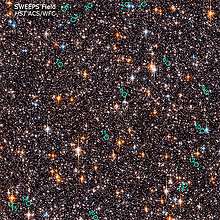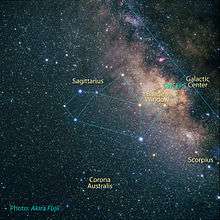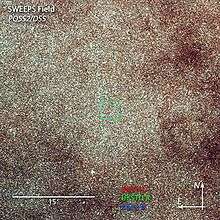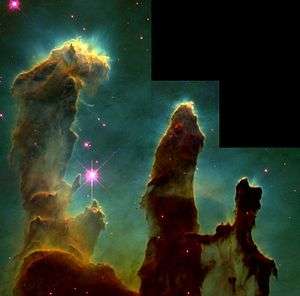Sagittarius Window Eclipsing Extrasolar Planet Search
The Sagittarius Window Eclipsing Extrasolar Planet Search, or SWEEPS, was a 2006 astronomical survey project using the Hubble Space Telescope's Advanced Camera for Surveys - Wide Field Channel to monitor 180,000 stars for seven days to detect extrasolar planets via the transit method.[1]
 Detail image with exoplanet locations indicated with green circles. | |
| Alternative names | SWEEPS |
|---|---|
| Survey type | astronomical survey |
| Target | exoplanet |
| Organization | NASA, European Space Agency, Space Telescope Science Institute |
| Observations | Advanced Camera for Surveys, Hubble Space Telescope |
Area examined


The stars that were monitored in this astronomical survey were all located in the Sagittarius-I Window.[2] The Sagittarius Window is a rare view to the Milky Way's central bulge stars: our view to most of the galaxy's central stars is generally blocked by lanes of dust.[3] These stars in the galaxy's central bulge region are approximately 27,000 light years from Earth.[2]
Planets discovered
Sixteen candidate planets were discovered with orbital periods ranging from 0.6 to 4.2 days. Planets with orbital periods less than 1.2 days have not previously been detected, and have been dubbed "ultra-short period planets" (USPPs) by the search team. USPPs were discovered only around low-mass stars, suggesting that larger stars destroyed any planets orbiting so closely or that planets were unable to migrate as far inward around larger stars.[4]
Planets were found with roughly the same frequency of occurrence as in the local neighborhood of Earth.[2]
SWEEPS-4 and SWEEPS-11 orbited stars that were sufficiently visually distinct from their neighbors that follow-up observations using the radial velocity method were possible, allowing their masses to be determined.[2]
This table is constructed from information obtained from the Extrasolar Planets Encyclopedia and SIMBAD databases that reference the Nature article as their source.[4]
| Star | Constellation | Right ascension |
Declination | App. mag. |
Distance (ly) | Spectral type |
Planet | Mass (MJ) |
Radius (RJ) |
Orbital period (d) |
Semimajor axis (AU) |
Orbital eccentricity |
Inclination (°) |
Discovery year |
|---|---|---|---|---|---|---|---|---|---|---|---|---|---|---|
| SWEEPS J175853.29-291233.5 | Sagittarius | 17h 58m 53s | −29° 12′ 33″ | 22.2 | ~22000 | SWEEPS-01 | ? | 1.01 | 1.56 | 0.025 | ? | 86+ | 2006 | |
| SWEEPS J175853.38-291217.8 | Sagittarius | 17h 58m 53s | −29° 12′ 18″ | 25.1 | ~22000 | SWEEPS-02 | ? | 1.37 | 0.912 | 0.015 | ? | 86+ | 2006 | |
| SWEEPS J175853.57-291144.1 | Sagittarius | 17h 58m 53s | −29° 11′ 44″ | 22.5 | ~22000 | SWEEPS-03 | ? | 0.87 | 1.27 | 0.021 | ? | 86+ | 2006 | |
| SWEEPS J175853.92−291120.6 | Sagittarius | 17h 58m 54s | −29° 11′ 21″ | 18.8 | ~22000 | SWEEPS-04 | <3.8 | 0.81 | 4.2 | 0.055 | ? | 87+ | 2006 | |
| SWEEPS J175854.60-291128.2 | Sagittarius | 17h 58m 55s | −29° 11′ 28″ | 23.9 | ~22000 | SWEEPS-05 | ? | 1.09 | 2.313 | 0.030 | ? | 87+ | 2006 | |
| SWEEPS J175857.29-291253.4 | Sagittarius | 17h 58m 57s | −29° 12′ 53″ | 19.5 | ~22000 | SWEEPS-06 | ? | 0.82 | 3.039 | 0.042 | ? | 86+ | 2006 | |
| SWEEPS J175857.69-291114.5 | Sagittarius | 17h 58m 58s | −29° 11′ 15″ | 21.5 | ~22000 | SWEEPS-07 | ? | 0.9 | 1.747 | 0.027 | ? | 86+ | 2006 | |
| SWEEPS J175859.24-291328.7 | Sagittarius | 17h 58m 59s | −29° 13′ 29″ | 21.7 | ~22000 | SWEEPS-08 | ? | 0.98 | 0.868 | 0.017 | ? | 84+ | 2006 | |
| SWEEPS J175859.60-291211.8 | Sagittarius | 17h 59m 00s | −29° 12′ 12″ | 22.5 | ~22000 | SWEEPS-09 | ? | 1.01 | 1.617 | 0.025 | ? | 86+ | 2006 | |
| SWEEPS J175902.00-291323.7 | Sagittarius | 17h 59m 02s | −29° 13′ 24″ | 26.2 | ~22000 | SWEEPS-10 | ? | 1.24 | 0.424 | 0.008 | ? | 84+ | 2006 | |
| SWEEPS J175902.67−291153.5 | Sagittarius | 17h 59m 03s | −29° 11′ 54″ | 19.83 | ~22000 | SWEEPS-11 | 9.7 | 1.13 | 1.796 | 0.03 | ? | 84+ | 2006 | |
| SWEEPS J175904.44-291317.1 | Sagittarius | 17h 59m 04s | −29° 13′ 17″ | 21.8 | ~22000 | SWEEPS-12 | ? | 0.91 | 2.952 | 0.038 | ? | 87+ | 2006 | |
| SWEEPS J175905.95-291305.6 | Sagittarius | 17h 59m 04s | −29° 13′ 17″ | 21.38 | ~22000 | SWEEPS-13 | ? | 0.78 | 1.684 | 0.027 | ? | 86+ | 2006 | |
| SWEEPS J175907.56-291039.8 | Sagittarius | 17h 59m 04s | −29° 13′ 17″ | 22.38 | ~22000 | SWEEPS-14 | ? | 0.93 | 2.965 | 0.037 | ? | 87+ | 2006 | |
| SWEEPS J175907.64-291023.7 | Sagittarius | 17h 59m 04s | −29° 13′ 17″ | 25.66 | ~22000 | SWEEPS-15 | ? | 1.37 | 0.541 | 0.010 | ? | 84+ | 2006 | |
| SWEEPS J175908.44-291140.6 | Sagittarius | 17h 59m 08s | −29° 11′ 41″ | 23.78 | ~22000 | SWEEPS-16 | ? | 1.4 | 0.969 | 0.017 | ? | 85+ | 2006 |
See also
- Baade's Window
- Optical Gravitational Lensing Experiment or OGLE also examines the galactic bulge for planets.
References
- "SIMBAD Details on Acronym: SWEEPS". SIMBAD. Centre de Données astronomiques de Strasbourg. Retrieved 2009-05-21.
- Sahu, K. C.; et al. (2007). "Planets in the Galactic Bulge: Results from the SWEEPS Project". ASP Conference Series. 393: 93. arXiv:0711.4059. Bibcode:2008ASPC..398...93S.
- Piotr Popowski; Kem Cook; Andrew Becker (December 2003). "The Large-Scale Extinction Map Of The Galactic Bulge From The MACHO Project Photometry". The Astronomical Journal. 126 (6): 2910–2921. arXiv:astro-ph/0303075. Bibcode:2003AJ....126.2910P. CiteSeerX 10.1.1.255.3790. doi:10.1086/379291.
- Sahu, K. C.; et al. (2006). "Transiting extrasolar planetary candidates in the Galactic bulge". Nature. 443 (7111): 534–540. arXiv:astro-ph/0610098. Bibcode:2006Natur.443..534S. doi:10.1038/nature05158. PMID 17024085.


